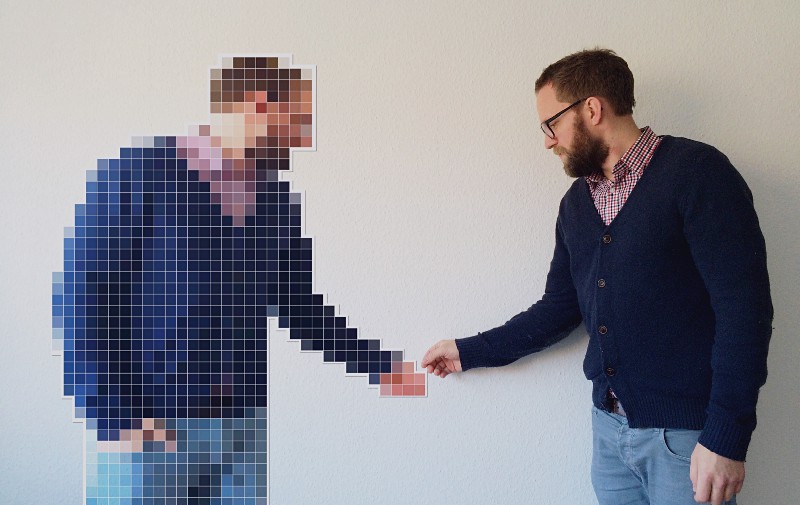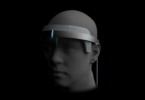“Everything Is Connected” says the neon lettering on a sculpture in a leafy park in Wakefield, England.
It is about to become true. Literally.
If pundits are right, everything from our own identities to the diamond earrings on our earlobes to the sneakers on our feet, the tuna we buy in the supermarket and the cars we drive, will all be digitized and linked to the Internet.
Up until now governments have owned peoples’ identities through the issuing of social security numbers, passports, identity cards and birth and death certificates. And some of the largest Internet companies, including Google and Facebook, have been reaping most of the profits from collecting, aggregating, analyzing and monetizing personal data.
But the use of modern cryptography and introduction of new technologies such as blockchain — an immutable ledger that allows third parties to validate that an attribute has not been changed or misrepresented — could help humans obtain self-sovereign identity, digital identities that remain entirely under an individual’s control.
Giving identity to non-human objects has far-reaching benefits for the 4th industrial revolution. In sectors such as aerospace and manufacturing, the pairing of the virtual and physical worlds already allows the analysis of data and monitoring of systems to head off problems before they even occur. It can also prevent downtime, develop new opportunities and help planning for the future by using simulations.
In the future digital twinning is expected to introduce end-to-end visibility in supply chains, prevent counterfeiting and allow for interaction with customers that buy an object — via that object — over the lifetime of a product, forming the foundation for connected products and services.
The potential upside is huge.
Secure, immutable digital IDs could help achieve one of the United Nations’ Sustainable Development Goals: providing every person on the planet with a solid and tamper-proof digital identity based on common, interoperable standards by 2030. As a first step, the United Nations is seeking to develop scalable identity systems by 2020. The aim is to help the some 1.1 billion people — including many displaced persons — who currently have no means of identification, meaning they can’t vote, go to school or receive government services.
The introduction of secure digital identities could also make many existing authentication processes obsolete and save everyone billions of wasted hours annually, significantly improving privacy and security.
Today when people want their identities to be confirmed they have to transfer information such as their name, address and social security. The entity to which they sent that information retains it, meaning the data is out there in silos, creating both risks in terms of data loss and forcing companies that might not want to be in that position to store that information. It also enables businesses to harvest peoples’ personal data for commercial purposes that do not necessarily benefit the owner of the data.
All of that changes once the owners of the data are in control and can decide to share only the information they want, when they want, with whom they want. Modern cryptography –such as zero knowledge proof systems or secure Multi-Party computing –enables an individual to provide proof to a third party without sharing personal data. For example, a person could prove they are over 18 without revealing their exact birth date.
It could make it safe to share medical records electronically and for governments and global NGOs to introduce new electronic services based on digital IDs. Estonia led the way, but now governments in many countries including Canada, the Netherlands, Switzerland, Brazil, India, Dubai and the U.S are trialing secure digital ID services. So are NGOs. In trials in Pakistan and at a refugee camp in Jordan, the United Nations World Food Program has tested a blockchain-based digital ID service coupled with the use of biometric information to make cash-based transfers, through vouchers or pre-paid debit cards — to allow people in need to purchase their own food.
It doesn’t stop there. Self-sovereign IDs looks poised to have a big impact on the way everyone buys and sell goods.
Secure IDs are expected to lead the way for a process called intent casting, a means to allow buyers to more effectively and efficiently broadcast their purchase plans and qualify the sellers. With trusted digital IDs all the information needed, such as proof of ownership, product history and buyer reputation, could be shared between the buyer and seller without revealing personal information such as full name, home address or email — all without the need for middlemen.
“Say I want to refinance a €800,000 home,” says Timothy Ruff, co-founder and CEO of the U.S. digital ID startup Everynym. “I would be able to release proof that I own it, proof that I am who I say I am and proof that I can be trusted through some kind of a rating agency. Instead of buying me as a lead or advertising through Facebook or Google, companies selling home mortgages would be able to go straight to me and use the money they would have spent on advertisers to give me a better deal.” He adds: “This whole system of intermediaries in the form of search engines, Facebook and AdWords would be flipped on its head. It is potentially very disruptive.”
Once objects such as motorcycles have digital IDs they could be trusted to make transactions on their owner’s behalf. So sometime in the not-too-distant future an owner might text a motorcycle she owns and tell it to go sell itself. With the permission of both buyer and seller, follow-on services, such as bids to provide insurance to the new owner of the motorcycle, could be provided.
Trusted digital IDs could also open new opportunities for existing businesses to create new revenue streams. Banks or Amazon or Alibaba could offer identity management as a separate, fee-based service. They could, for example, serve as brokers of digital data, gathering — at a customer’s request — all of the digital documents needed from different sources for an individual customer to gain approval from an owner to rent or buy an apartment.
The World Economic Forum argued in a 2016 report that there is a strong business case for banks to move into such services. Since then other industries — including the travel and health sectors — have expressed interest in how to best establish and use secure digital IDs, prompting the Forum to launch a cross-industry initiative to find a way forward, says Daniel Dobrygowski, the Forum’s project lead [KCT1] on Trust and Resilience. While there is a need for an international approach, establishing agreements will be anything but easy, due to technical, cultural and commercial issues.
The Twinning of Things
Humans aren’t alone in needing digital identities. The world is not yet fully reaping the benefits of the Internet of Things because supply chains are not transparent or interoperable, there is no trustworthy machine-to-machine communications mechanism and there is fear about the risk of data tampering. What’s more, there is no way of having a provable, traceable data trail, and no control over where the data goes.
That is expected to change once everything has a digital twin, a data model of a real-life machine, product or service with a unique immutable identity, says Carsten Stoecker, a council member of the World Economic Forum’s Global Future Network and CEO of Spherity, a German startup that aims to link the identity of everyone and everything to a digital twin.
Think of a digital twin as a bridge between the physical and digital worlds. Sensors that gather data about real-time status, working condition, or position are integrated with a physical item. The components are connected to a cloud-based system that receives and processes all the data the sensors monitor. This input is analyzed against business and other contextual data. Information gleaned within the virtual environment can then be applied to the physical world to improve performance of everything from an airplane part to an entire factory.
GE helped pioneer the field of digital representation of a physical asset and its context within an enterprise to understand the past and predict future outcomes.
In contrast to cloud-based systems, digital twinning in combination with blockchain can and will be used in many other ways because the technology enables reliable interoperability, trusted transactions, proof of authenticity, full audit trailing and the collection of lifecycle data for product development and for tax automation, says Stoecker, who recently left a job as a manager in the machine economy innovation program at the German energy company innogy SE to co-found Spherity.
Take the case of cars. Spherity’s digital twinning technology allows the capturing of car data during a vehicle’s entire lifecycle. It can provide a non-tampered mileage history, preventing odometer fraud; help establish pay-per-use tailored insurance or leasing models; and permit the running of artificial intelligence analysis on telematics data.
The German startup’s technology also allows machines to enable pay-per-use models for renting or leasing, for service tracking and monitoring and predictive maintenance analysis.
Spherity additionally plans to apply its technology to digitize green energy assets for peer-to-peer energy trading and to create tracing apps for digital twin supply-chain tracking.
Other startups are using digital twinning to track and establish the provenance of fast-moving consumer goods.
For example, Provenance, a British startup, puts a unique QR code on Near Field Communication (NFC)-enabled smart stickers that are placed on items like cans of tuna. Touching a smartphone over the stickers shows the product’s journey from sea to supermarket.
Luxury goods are also being twinned. Everledger, a British startup, uses the blockchain to provide an immutable ledger to digitally identify individual diamonds, their ownership and related transaction history verification while Chronicled, a San Francisco-based startup, is using blockchain-supported digital ID technology to tackle counterfeiting of everything from fine art to expensive, original sneakers. By placing microchips onto or inside of virtually any physical object, Chronicled can register critical identifying data about that object onto the blockchain, authenticating it as the original and tracking each step in its purchasing history.
Avoiding Replication of Existing Issues
While this all sounds great, it could be a while before everybody and everything has a digital twin and interconnections run smoothly and securely.
In some countries there will be centralized digital ID programs, but in cases where there is lack of trust in the government or in the ability of the government to coordinate, a federated or more distributed approach might be used. Agreement needs to be reached on consumer rights and a ndw model developed for data owners to share and be compensated for their personal data, says Thomas Hardjono, Technical Director At MIT Internet Trust Consortium- MIT Connection Science and the co-authory, with Alex “Sandy” Pentland of the book “TrustData: A New Framework for Identity and Data Sharing.”
Other issues also need to be resolved. “I am a physicist by training so I figured how hard can this be? I thought identity was pretty simple but actually it is not,” says Spherity’s Stoecker.
Big Tech companies can attest to that. Microsoft tried to introduce a digital ID system called Passport about 15 years ago; Intel, Sun, Oracle and AOL attempted to develop such a service through a group called The Liberty Alliance. Neither service caught on.
Fast forward to the present and there is no consensus on what is the right technology to use or how evolving approaches might interoperate.
For example, Spherity is attempting to build a decentralized, encrypted peer-to-peer transaction layer bridging the physical, biological and digital spheres. The not-for-profit Sovrin Foundation is building a public distributed ledger that aims to provide a standard way to create decentralized, permanent, globally unique, cryptographically verifiable identifiers that are owned and controlled by their creators. Its technology is being tested in Finland. ConsenSys, a global formation of technologists and entrepreneurs, is building software and enterprise solutions based on the Ethereum platform. One of its products, uPort, a blockchain-based self-
sovereign ID system, is being piloted in Brazil and in Switzerland. SecureKey, a Canadian startup specialized in digital information security, authentication and identity management, is combining its tech with IBM’s blockchain to roll out a nation-wide digital ID service in Canada involving the government, telecom companies and the country’s largest banks. The Swiss technology company WISeKey, which has developed its own dual factor digital ID authentication technology, has teamed with the government in the Indian state of Andhra Pradesh to explore the use of blockchain to secure data and announced earlier in January that it will launch a digital identification and secure cloud services for Chinese consumers.
That’s not all. U.S. tech giants are not ready to cede the market to upstarts and are putting the building blocks in place for their own new digital ID services.
The World Economic Forum is in a unique position to bring together governments as well as competing commercial players and opensource actors to help people and objects obtain secure digital identities and ensure that emerging platforms and services interoperate, says Stoecker.
In forging a path forward, it will be important to guard against one company or group of companies dominating, he says. Otherwise digital twins won’t just be replicating objects and people, they will mirror the mistakes made when the Internet was launched by putting control of personal data and the majority of profits in the hands of too few players.







